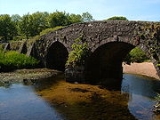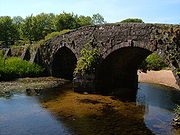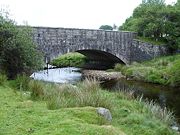
Two Bridges
Encyclopedia


Dartmoor
Dartmoor is an area of moorland in south Devon, England. Protected by National Park status, it covers .The granite upland dates from the Carboniferous period of geological history. The moorland is capped with many exposed granite hilltops known as tors, providing habitats for Dartmoor wildlife. The...
National Park in Devon
Devon
Devon is a large county in southwestern England. The county is sometimes referred to as Devonshire, although the term is rarely used inside the county itself as the county has never been officially "shired", it often indicates a traditional or historical context.The county shares borders with...
, England. It is situated around 2.5 km (1.6 mi) north east of Princetown
Princetown
Princetown is a town situated on Dartmoor in the English county of Devon.In 1785, Sir Thomas Tyrwhitt, Secretary to the Prince of Wales, leased a large area of moorland from the Duchy of Cornwall estate, hoping to convert it into good farmland. He encouraged people to live in the area and suggested...
on the old turnpike
Turnpike trust
Turnpike trusts in the United Kingdom were bodies set up by individual Acts of Parliament, with powers to collect road tolls for maintaining the principal highways in Britain from the 17th but especially during the 18th and 19th centuries...
road which was built across Dartmoor in the late 18th century (now known as the B3212).
A map dated 1765 suggests the origin of the name, for in those days the road crossed both the West Dart and the River Cowsic, just upstream from the point where they meet, and required two separate bridges.
By 1891, these had disappeared and there was just a single bridge, further downstream, over the West Dart. Today, however, there are again two bridges on the site, because a more modern structure has been added alongside its earlier predecessor, to carry modern traffic. Visitors often mistakenly assume that these are the same two bridges that gave the name to the site.
In the 18th century, Two Bridges was best known for its potato
Potato
The potato is a starchy, tuberous crop from the perennial Solanum tuberosum of the Solanaceae family . The word potato may refer to the plant itself as well as the edible tuber. In the region of the Andes, there are some other closely related cultivated potato species...
market. The site was no doubt chosen because it is in a central location, and easily accessible on what was then, and still is now, the only usable road across Dartmoor. Some small quarries in the vicinity show that there was also light industry in the area.
Those who met and worked in this remote spot were able to gain refreshment and lodging at the Saracen's Head. It was built in 1794 as a coaching inn
Coaching inn
In Europe, from approximately the mid-17th century for a period of about 200 years, the coaching inn, sometimes called a coaching house or staging inn, was a vital part of the inland transport infrastructure, as an inn serving coach travelers...
, and still stands there today, although it is now known as the Two Bridges Hotel.
It continues to be a popular meeting point for tourists and walkers. The area is also surrounded by prehistoric antiquities, including Bronze age
Bronze Age
The Bronze Age is a period characterized by the use of copper and its alloy bronze as the chief hard materials in the manufacture of some implements and weapons. Chronologically, it stands between the Stone Age and Iron Age...
settlements, stone row
Stone row
A stone row , is a linear arrangement of upright, parallel megalithic standing stones set at intervals along a common axis or series of axes, usually dating from the later Neolithic or Bronze Age. Rows may be individual or grouped, and three or more stones aligned can constitute a stone row...
s and an impressive standing stone
Standing stone
Standing stones, orthostats, liths, or more commonly megaliths are solitary stones set vertically in the ground and come in many different varieties....
, the Beardown Man, situated to the north west. The Devonport Leat
Devonport Leat
The Devonport Leat was a leat constructed in the 1790s to carry fresh drinking water from the high ground of Dartmoor to the expanding dockyards at Devonport, Devon, England. It is fed by three Dartmoor rivers: the West Dart, the Cowsic and the Blackabrook...
- a man-made waterchannel - passes nearby.

